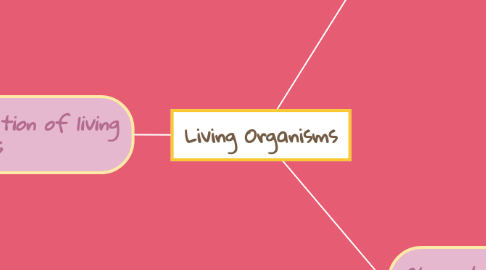
1. Classification of living organisms
1.1. Binomial System Notes
1.1.1. Organisms were initially classified by Linnaeus in a way that allowsthe subdivision into smaller and more specialized groups
1.1.2. The species in these groups have more and more features in common the more subdivided it gets
1.1.3. Linnaeus named organisms in Laitin using what we call the BINOMIAL SYSTEM
1.1.4. The scientific name for an organism is made up of 2 parts. The genus and then the species
1.1.4.1. Genus
1.1.4.1.1. Written first with a capital letter
1.1.4.2. Species
1.1.4.2.1. Written after the genus and begins with a lower case letter
1.1.5. Scientific name is written in italics [this indicates that they are latin]
1.1.6. The sequence of classification in descending order [general to specific]
1.1.6.1. Kingdom, Phylum, Class, Order, Family, Genus, Species
1.2. Binomial System
1.2.1. Kingdom
1.2.2. Phylum
1.2.3. Class
1.2.4. Order
1.2.5. Family
1.2.6. Genus
1.2.7. Species
2. Easy way to remember characteristics of living organisms
2.1. MRS GREN
2.1.1. M
2.1.1.1. Movement
2.1.2. R
2.1.2.1. Respiration
2.1.3. S
2.1.3.1. Sensitivity
2.1.4. G
2.1.4.1. Growth and development
2.1.5. R
2.1.5.1. Reproduction
2.1.6. E
2.1.6.1. Excretion
2.1.7. N
2.1.7.1. Nutrition
2.2. Side Note
2.2.1. Sometimes people add an H between mrs and gren so that they can include homeostasis
2.2.1.1. Homeostasis is a property of cells that allows the maintenance and regulation of the stability and consistency needed to function properly
3. Characteristics of living organisms
3.1. Movement
3.1.1. An action by an organism or part of an organism resulting in a change in position or place
3.2. Respiration
3.2.1. The breakdown of nutrient molecules in living cells to release energy for metabolism
3.3. Sensitivity
3.3.1. The ability to sense stimuli in the internal or external environment and to respond appropriately
3.4. Growth
3.4.1. The permanent increase in size and dry mass by an increase in cell number, cell size or both
3.5. Reproduction
3.5.1. The process of making more of the same kind of organism
3.6. Excretion
3.6.1. Removal of toxic materials, waste products of metabolism and substances in excess
3.7. Nutrition
3.7.1. Intake ofmaterials for energy, growth and development
3.7.1.1. Plants require light, carbon dioxide, water and ions
3.7.1.2. Animals need organic compounds, ions and usually need water
